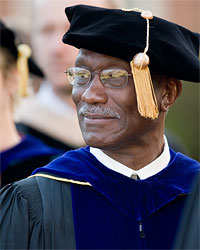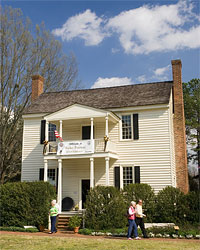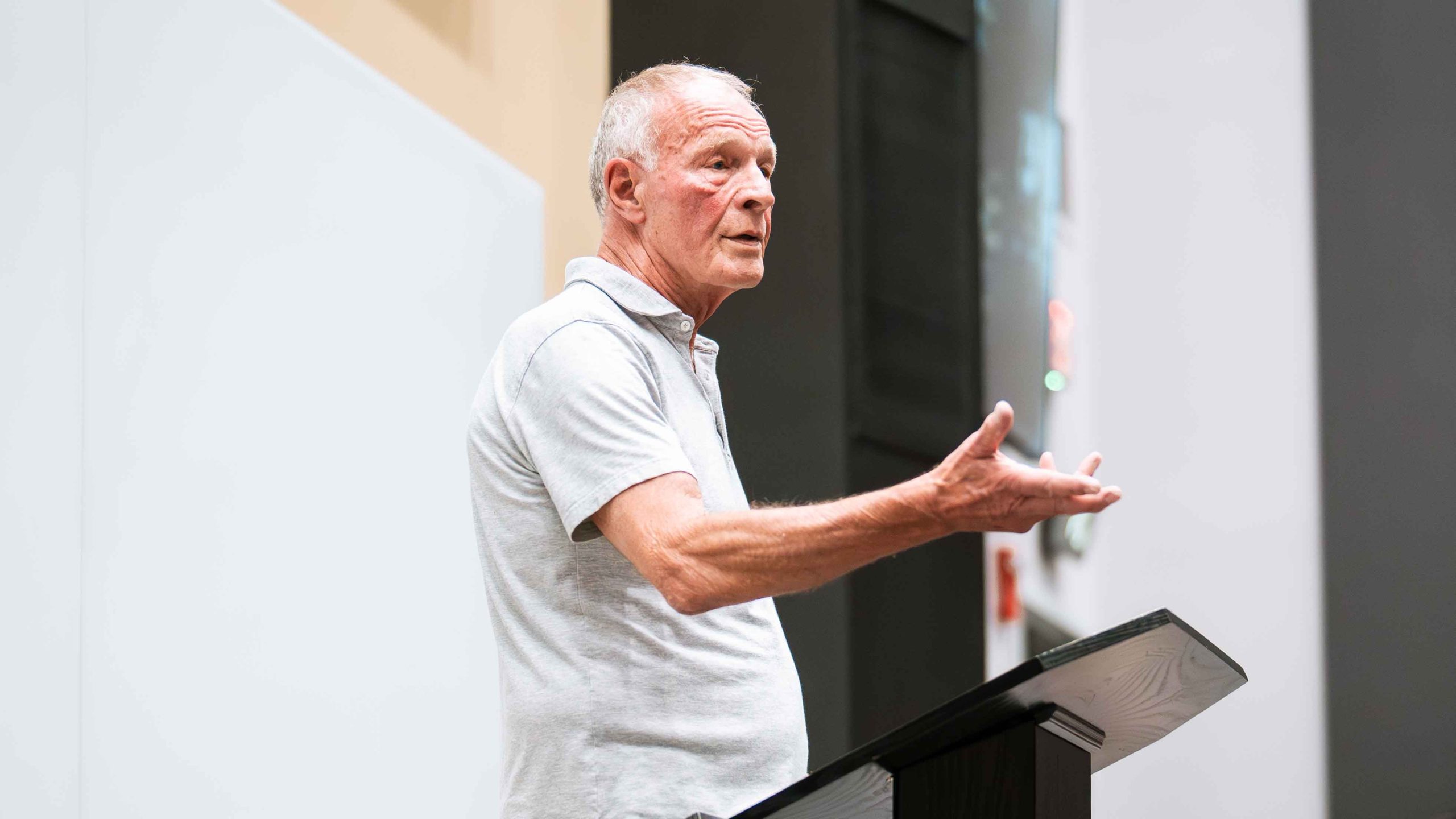Using our Past as a Roadmap for Charting our Future: The Evolutionary History of Wake Forest University
Founders’ Day Convocation
February 7, 2008
Wait Chapel, Wake Forest University
Herman E. Eure
Professor of Biology

Herman Eure (PhD ’74)
President Hatch, Members of the Board of Trustees, Faculty Colleagues, Students, Honored Guests, and Visitors. I am pleased and honored to have been invited to speak to you on the Anniversary of the founding of this great University. When Provost Tiefenthaler told me last fall that she was planning to change the format of the founder’s day “celebration”, moving the convocation to the afternoon and having speakers who were familiar with the history of the university, including faculty, as keynote speakers, I was delighted. If I had known at the time that I would be invited to deliver the first talk under this new format however, I might have tempered my enthusiasm.
When I talk to parents and students as a part of the Admissions office recruitment sessions, I make a point of telling them that I have agreed to talk to them because I believe in Wake Forest and that it is easy to sell something that you believe in. This convocation provides me with that same opportunity. Wake Forest is a good place, and I have truly enjoyed my long association with this institution.
James Hutton, a Scottish geologist, stated to his fellow geologists in the early 19th century, that “The present is a key to the past”; meaning that those processes that were creating geological structures during their time were the same processes that had created these structures in the past. I would extend Hutton’s thesis by adding, “The present is a key to the past, but the past is a roadmap for charting the future”. How we responded to hardships, challenges, opportunities, and successes in the past provides us with a historical blueprint that can be used to predict how we will respond to similar situations in the future.
I am a parasite ecologist by training but an evolutionary biologist by choice. Thus, I tend to view the world through the lens of evolutionary relationships and events. Today I want to show you some of the parallels between what I study and teach in my evolution class and how that relates to the evolution of the species that we know as Wake Forest University. Along the way, I will tell you about some of the people and some of the events that shaped our character as an academic institution.
I came to Wake Forest in 1969 as a graduate student in the Department of Biology. In the spring of 1974, my advisor, Dr. Gerald W. Esch, called to tell me that the Department was interested in hiring me as an assistant professor. My initial response was, No, not because it wasn’t a good place to be, but because I thought that I should go some where else to start my career. After thinking about the offer and discussing it with a few friends, I decided to, at least, do the interview and, as the old saying goes, the rest is history. When I accepted the position in the Department of Biology, I had planned on staying at Wake Forest for only 2 years. That was 34 years ago, or 17 two year stints. One of the questions that I have been asked over the years has been, why did you stay? People knew that the climate for a Black faculty member at any school in the south during that period must have been difficult. The reason that I stayed, however, is very simple. Wake Forest has a way of getting under your skin. I, like many other sons and daughters of this institution, feel a connection to Wake Forest that is, frankly, hard to describe. It is what former Vice-President, Bill Joyner, always referred to as the “Wake Forest Mystique”. Its commitment to the liberal arts tradition, its sense of community, its concern for its faculty, staff, and students, an emphasis on excellent teaching, its commitment to North Carolina and it citizens, and a powerful commitment to the service of humanity, all combine to make Wake Forest a unique and very special place.
As I mentioned, my experience with Wake Forest began in the fall of 1969 with the Winston-Salem version of the school. I had had no experience with the Wake Forest that grew up in the town of Wake Forest and that had matured into one of the best church related schools in the southeast. So, when older faculty and alumni talked about the old campus, its close knit family atmosphere, and its intimate associations with the townspeople, I had no concept of their Wake Forest. Evolutionary biologists study the past in an attempt to understand how we got to where we are and to predict where we might go in the future. Therefore, to correct this deficiency in my Wake Forest education and to see if I could discern how we got started as an academic institution, I, along with several friends, including Chaplain Emeritus Ed Christman and his wife, Jean, went to visit the old campus in October of 2004.

The Calvin Jones House on the Old Campus of Wake Forest.
We arrived at the Calvin Jones House where we were met by Susan Brinkley, class of 1962, and Charlotte Easley Shaw, class of 1944, and the daughter of the late J. Allen Easley, Professor of Religion. The Calvin Jones House was the residence of Samuel Wait, the first President of the College. It now serves as the birthplace museum and as the centerpiece of any tour of the Old Campus. Our campus tour included the administration building, the library, which housed the old law school, Binkley Chapel, which is the model for our own Wait Chapel and the church that was started by the students in 1835.
Our last stop was the cemetery. It was like walking through Wake Forest family history. Gravestone markers and monuments of the Waits, the Brewers, the Timberlakes, the Lanneaus’, the Arringtons, the Wingates, and, of course, the Poteats, pepper the green rolling hills of this cemetery. Another cemetery, a short distance away, is thought to be the final resting place of Tom Jeffries, the black gardener and grounds keeper. The funeral of “Dr. Tom”, as he was called, was probably the first integrated event on the old campus.
We left the cemetery and drove down the main street on our way out of town, but then decided to go back to sample the hotdogs at Shorty’s, the original Shorty’s. Much to our dismay, however, Shorty’s closed at 3 p.m. on Saturdays, so we did not get a chance to sit at the bar and reminisce.
As we drove back to Winston-Salem, I began to get a sense of some of the academic traditions that had made us into one of the best small colleges in the southeast. So, today what I want to do is to try to connect the lines of history between that Wake Forest and the Wake Forest of today.
If you looked up the word evolution, you would see that e means, out, and volution means, turning or folding. Taken together, evolution refers to the unfolding of a pattern. In biology, we call this pattern of unfolding, the process of genetic change through time. Evolution can take a number of different patterns in producing a species; branched lineages, where several groups share a common ancestor, or unbranched, single group lineages. One particular type of unbranched lineage is called phyletic transformation. In this scheme, an ancestral lineage produces a modern form of that lineage via gradual shifts in the genetic makeup of the original gene pool. A new version of the ancestral species replaces each former species in the lineage, ultimately producing a modern version of the lineage. The best example of phyletic transformation is the Horse. Since its appearance on the scene some 55 million years ago, there has always been a species that we can call a horse, i.e., Eohippus, Mesohippus, Merychippus, and Equus, today’s horse. The same pattern that produced a modern version of the horse lineage can also be used to show the evolution of our own institution. Hence, the Wake Forest of today is a modern form of the ancestral lineage that we first knew as the Wake Forest Manual Labor Institute, then Wake Forest College, and now, as Wake Forest University.
The first stage in our evolution began in the forests of Wake County, near Raleigh, as the Wake Forest Manual Labor Institute. The Manual Labor Institute was re-chartered in 1838 and given the official name Wake Forest College. The school established several traditions during its early years, including the training of ministers and the educating of first generation North Carolinians. It also chose as its motto “Pro Humanitate” — service to humanity. These traditions were deeply embedded in the fabric of the college and helped to define the school’s character and its mission. A law school was established in 1894 and a 2 year School of Medicine followed in 1902.
The second stage in the evolutionary history of the College began in 1905 with Dr. William Louis Poteat. Dr. Poteat was the first layperson to be appointed President of the College and his impact on the College was profound. He continued the growth of the college, adding many outstanding professors to the faculty ranks and expanding the college’s science curriculum. Dr. Poteat, himself a biologist, created quite a stir among the North Carolina Baptists with his strong support of the right of his faculty to teach evolution. This stance put Wake Forest on the map so to speak and at the same time generated quite a bit of tension with its founding body. Two other events also helped to signal the transition of the small school into a new stage in its development. In 1941, the Medical School relocated to Winston-Salem, and became the Bowman Gray School of Medicine and thankfully, in 1942, women were admitted as fulltime students for the first time; ‘a blessed event’, as Provost Emeritus Edwin G. Wilson puts it.
The appointment of Dr. Harold W. Tribble as President in 1950 ushered the College into the third stage of its lineage. Dr. Tribble oversaw the most profound change the school was to experience in its 174 year history. In response to an offer of a perpetual endowment from the Z. Smith Reynolds Foundation, Wake Forest picked up, lock, stock, and barrel and moved the entire campus, including faculty, students, and staff, to Winston-Salem. This bold move was, without question, the most significant event in the evolutionary history of the institution to that point. We also left a community where faculty and staff were so much an integral part and embarked on a journey that would take the school to a place where, in some respects, it would have to start over. Moreover, the move, or “removal”, as it was called by the people of Wake Forest, was to set the school and the Baptist State Convention on a course that would forever alter their relationship. A Graduate School of Arts and Sciences was established in 1961 and, in the summer of 1962, the College admitted its first fulltime black student. Ironically, he was an African named Edward Reynolds.
Although the College was thought to be somewhat conservative in its politics, freedom of expression, and inquiry were always strong traditions at Wake Forest. During the 1960’s, other schools in the state imposed a speaker ban on individuals whose viewpoints they deemed inappropriate for their students to hear. In contrast, Wake Forest welcomed the opportunity to expose its students to a variety of ideas and viewpoints. The most notable examples of this right to free expression occurred when the Civil Rights activist, the Reverend Dr. Martin Luther King, Jr. and the head of the American Nazi Party, Mr. George Lincoln Rockwell, were both invited, at different times, of course, to speak at Wait Chapel.
The fourth stage in the evolution of Wake Forest began with the appointment of Dr. James Ralph Scales in 1967. Dr. Scales took the small school from College to University status, establishing it as the best private Liberal Arts University in the region.
During the Scales era, two events created a deepening of the gulf between the University and the Convention over control of University operations; First, Dr. Scales’ defense of our students right to have Larry Flynt, Publisher of Hustler magazine, as a speaker; and second, the acceptance of a federal grant awarded to the Biology Department for curriculum enhancement, including the construction of a new greenhouse. One could understand the Convention’s displeasure about the Larry Flynt situation, but the irony of the Biology Department conflict was that our medical school already received federal grants as a matter of routine. To make matters worse, the President of the Convention, in his effort to explain why the medical school could accept funds from the government, but not the college, stated that it was because the medical school provided a service and the Biology Department did not! Needless to say, his assertion was not received with much enthusiasm by members of the Biology Department. The University was asked to return the money and Dr. Scales and the Board of Trustees refused.
Because of the stance that it took on the Larry Flynt and the Biology Department grant controversies, the American Association of University Professors awarded The Board of Trustees the highly prestigious Mieklejohn Prize for Defense of Academic Freedom in 1978. In a statement acknowledging the award, Dr. Scales referred to Wake Forest as “a fortress of independent thought”.
The fifth stage in our lineage began in 1983 with the installation of Dr. Thomas K. Hearn, Jr. as the University’s 12th president. Several events signaled a new direction for the University. In 1986, the University’s Board of Trustees finally established itself as an independent governing board with the authority to select its own members. This move effectively severed the remaining official ties between the University and its founding body. I believe that this was the second most significant event in the school’s history. It allowed the school to seek a greater diversity among its Trustees, and it opened up doors of far greater financial support from other sources. The University’s status in the academic community soared and, for the first time in its history, the US News and World Report, ranked Wake Forest among the top 30 best national universities in the country.
I have spent a good bit of time talking about our academic traditions, our DNA, and their importance in helping us to define who and what we are. Tradition, in and of itself, may not always be good. Sometimes tradition can simply mean that you have been doing something wrong for a long time! Wake Forest, like most good academic institutions, has had some good and some not so good traditions. For example, we were, as I said, until 1942, an all male institution, there was no ethnic diversity, there was no coed housing and certainly there was no dancing. On the other hand, those core traditions that formed the unique character of Wake Forest, part of the mystique that I mentioned earlier, remain as relevant today as they were during the Poteat era. Knowing an institution’s historic traditions offer a perspective that may be crucial in deciding who you are and where you should go. “The present is a key to the past, but the past is a roadmap for charting the future”.
Wallace Stegner, who has been called the Dean of Western Writers, says this about traditions, and I quote: “No society is complete without both the will to create anew and the will to serve the best of the old; it is not the triumph of either tendency, but the constant elastic tension between the two that should be called our great tradition.” What are the best traditions of our past and how do we preserve them as we chart a new course? Our current strategic plan emphasizes five priorities which seek to combine the best of the old with the boldness of the new. Building academic programs of nationally recognized excellence, enhancing faculty distinction, attracting a talented, diverse student body and, developing them into competent leaders, creating a richer sense of community, and strengthening our connections to communities beyond our borders, all combine the best traditions of the old Wake Forest with our aspirations for the new Wake Forest.
Wake Forest occupies a truly unique niche among academic institutions. Our commitment to exceptional teaching, while also expecting our faculty to be productive scholars is a characteristic that sets us apart from many, if not most, of our peer institutions. However, as we strive to fulfill our aspiration for faculty distinction through our teacher-scholar ideal, let us not forget about the scholarly teachers. These are individuals whose understanding of new advances in their respective fields, coupled with their extraordinary ability of presentation, represents a unique and valued kind of scholarship in itself. Our history is replete with such individuals; Drs. William Louis Poteat, Charles M. Allen, J. Allen Easley, Edwin G. Wilson and James P. Barefield, just to name a few. I do not believe that our recognition of the scholarly teacher in any way diminishes or jeopardizes our commitment to the teacher-scholar ideal.
The phyletic transformation seen in the horse lineage started with a small animal, not much bigger than some present day dogs, but produced some great athletes in its modern iteration. Who among us cannot marvel at the prowess and beauty of a Secretariat, a Man-o-War, a Seattle Slew, or even a Sea Biscuit? Wake Forest, too, can boast of some giants in its history that changed the course of its development. Former Presidents Wait, Poteat, Tribble, Scales and Hearn, collectively moved their Wake Forest into new directions, directions that made us a better University. However, what remained constant in each of those iterations of Wake Forest was our commitment to our core traditional values, our DNA.
As I close, let me offer our current leaders a prescription for success in charting our future. As with the horse, the modern version of Wake Forest should be better than the old version, yet still reflect its ancestral lineage. Therefore, our strategic priorities should set forth our aspirations for what we want to become, and also, embrace the best traditions of our past. Thus, the courage of a James Ralph Scales and a Thomas K. Hearn, Jr., and their Boards of Trustees should serve as your guide for steering the University into a broader path of self determination; the boldness of a Harold W. Tribble should serve as your model for implementing the right kinds of change; and the vision of a William Louis Poteat should serve as your barometer for determining the appropriate amounts of growth and expansion the University can sustain. We must be an institution that remains committed to its core traditional values and constituencies, but also an institution that has the vision, daring, and courage to embrace new values and new constituencies. So, I would say, take the best traditions of our past, weave them together with the realities and limitations of the present, stitch in our aspirations for the future, and let the ‘elastic tension’ between these threads create a tapestry that, when examined, reveals a roadmap that can be used to chart our future course. If you do this, then we will truly be a modern version of a great ancestral lineage and the very best “Wake Forest” we can be. Thank You.
Categories: Happening at Wake, Research & Discovery
Wake Forest News
336.758.5237
media@wfu.edu
Meet the News Team
Wake Forest in the News
Wake Forest regularly appears in media outlets around the world.




